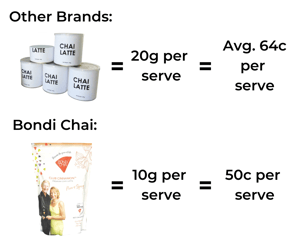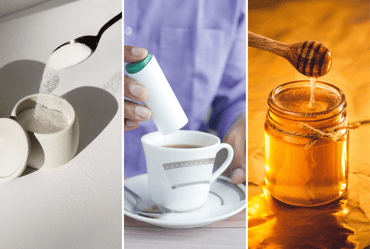We’ve previously talked about how Bondi Chai gets its amazing flavour and how we differ from other chai brands, but you may be curious to know what actually goes into Bondi Chai and why. Wonder no more, we’re about to solve the mystery!
The Inspiration: Chai Masala
‘Chai Latte’ is the western world’s answer to India’s ‘Chai Masala’, which is essentially their national drink. Every village has their own special chai masala recipe, but the common ingredients are black tea, cinnamon, clove, vanilla, ginger, cardamom, aniseed and sugar/jaggery/honey.
📷 @curryandlove via Unsplash
The basic process is to blend the black tea and rich spices, then steep in heated milk. The milk thickens over the heat and is sweetened with either sugar, jaggery, honey or molasses. Some villages, depending on their climate zone, also include black pepper and chilli powder in the mix. That sounds like a HOT drink, in more ways than one, but to each their own…
Bondi Chai’s Blend
Bondi Chai’s mixes include black tea extract, honey powder, our own blend of ‘comfort spices’, coconut sugar, cane sugar, whey powder, skim milk powder and natural flavouring. You can check out our nutritional panels for each variety here.
📷 @maudefl via Unsplash
While there’s a wide range of spices that can be used in chai, you won’t find cardamom in our Vanilla Honey or Club Cinnamon, and there’s a simple reason for this: the founders, Martin & Melissa, don’t like the taste of it. From day one, their credo was that they would only sell a product that they would want to drink themselves.
Now, you might think it a bold move to remove a traditional ingredient from the mix, however, it wasn’t without extensive testing and consideration. Martin & Melissa had been importing a US chai for distribution in Australia for 3 years before they decided to create their own blend.
No Fillers!
One point Martin & Melissa were adamant about was that the blend must dissolve completely in hot milk alone and that meant NO ARTIFICIAL FILLERS, thickeners, or emulsifiers, that stuff that looks like slippery sand in the bottom of the cup and means you can’t drink the whole thing… YUCK!
Standing their ground on this had its pros and cons for their product: the pros being that chai drinkers wouldn’t be faced with a cup full of unnecessary artificial ingredients that always seem to fall short on satisfaction and after-taste – and they’d be able to drink the whole cup; the cons were that they had to find a way to absorb the higher ingredient and production costs.
Expensive Ingredients
Chai latte was unknown when Martin & Melissa started their journey and there was a lot of strong debate with food scientists to get the recipes right for Bondi Chai’s first blends. The non-negotiable ‘fully milk-soluble’ requirement meant the need for specialised ingredients, and these came with a hefty price tag.
📷 @pokmer via Unsplash
The ingredients may have cost more than their equivalent weight in gold (literally), but the investment was worth it as they were also much more powerful, pure, and concentrated than their cheaper counterparts. The upshot of this was that the dosage rates for Bondi Chai’s blends are approximately half that of most other chai latte mixes on the market, so you actually get at least double the drinks out of each pack.

We compared serving sizes and costs of other brands and found that their current cost per serve is approx. 64 cents on average, with a serving size of 20g. Bondi Chai’s serving size is 10g, with a cost per serve being 50 cents. So not only do those excellent ingredients make a better chai latte (and helped Bondi Chai to become the most awarded product in the category) but they also deliver the best value for money.
Sugar
Yes, we know it’s considered a curse word these days. So many people are asking for sugar-free products - and we hear you. We researched this topic long and hard (and still do today) and we’re still convinced that using a sugar replacement simply just doesn’t cut it.

We’ve tried them all, truly, but in our many trials we found that sweeteners like Stevia, monk fruit and xylitol didn’t give the blend the same flavour – and worse, while the biggest claim of most non-sugar sweeteners is their low-calorie count, some serious questions are being asked about the overall health benefits of many of them. Of course, we didn’t want to use the large amounts of sugar traditionally used in chai masala recipes either, so we chose honey as the key sweetener with the absolute minimum of sugar. The result was using less than 6g (one teaspoon) per drink, which is the equivalent of the standard Aussie tea order of ‘white with one’.
The Test Panel
We mentioned earlier that Bondi Chai’s blends went through extensive testing, this included test panels. Our existing customers had already been drinking and serving the US-imported product for 3 years, so they were our go-to choice of tastebud-ready testers. Their assistance was invaluable in getting the recipes perfect for the flavours you know and love today.
We also gained some valuable take-aways from the testing process – other than perfecting our recipes – and that was to give us some valuable insights into the Australian palate, which prefers the richer and sweeter flavour profiles of what we’ve come to call ‘comfort spices’.
📷 @blackieshoot via Unsplash
So, there you have it! The next time you sit down to enjoy a cup of Bondi Chai you’ll know that for almost two decades now, we have been putting everything we have into making sure that you are drinking the best chai latte available anywhere in the world.